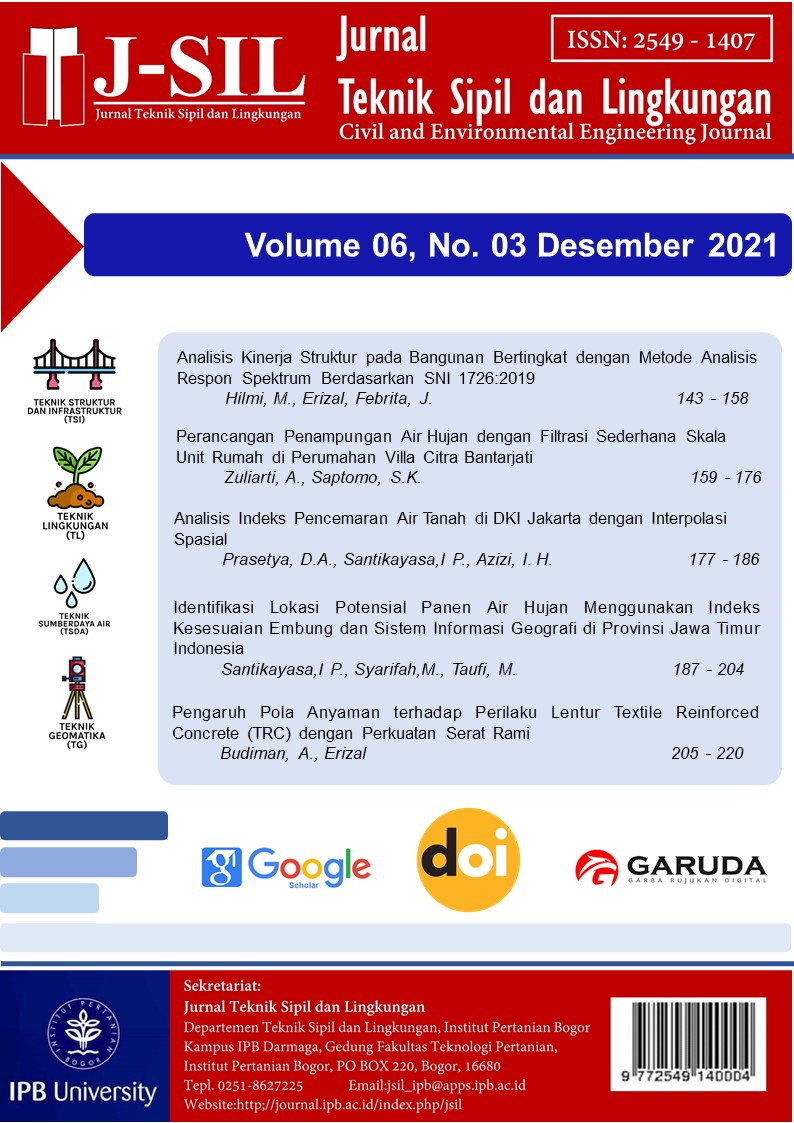Analisis Kinerja Struktur pada Bangunan Bertingkat dengan Metode Analisis Respon Spektrum Berdasarkan SNI 1726:2019
Analysis of Structure Performance in Multistory Buildings with Response Spectrum Analysis Method Based on SNI 1726:2019
Abstract
The issuance of SNI 1726:2019 indicates that the planning has passed a certain transition period so that the existing regulations will no longer apply. The planning that has been made for the Collaborative Research Center (CRC) buildings still uses the standards that were previously in place. This study aims to analyze the performance of structures in CRC buildings with spectrum response analysis methods based on SNI 1726:2019. The research method is carried out in several stages, starting from data collection, structure modeling, loading analysis, structure conformity analysis, and structure performance check. Modeling of CRC building structures is done based on the image of as built drawing contractors. Calculation of loading on building structures includes gravitational and lateral loads. The amount of mass participation obtained has been more than 90%, while the value of the period of structure and dynamic basic shear force has been controlled so that it meets the requirements in accordance with SNI 1726:2019. Based on the drift ratio value, the performance level of the CRC buildings is Immediate Occupancy (IO). The result of checking the influence of P-Delta obtained θ value does not exceed θmaks so that it can be categorized as safe.
Downloads
References
Arifin Z, Suyadi, Sebayang S. 2015. Analisis struktur gedung POP hotel terhadap beban gempa dengan metode pushover analysis. Jurnal Rekayasa Sipil dan Desain. 3(3):427-440.
[ATC] Applied Technology Council. 1996. Seismic Evaluation and Retrofit of Concrete Building Volume 1. ATC-40. California (US): ATC.
Avinash T, Pandian GAM. 2017. Investigation of the effects of p-delta on tubular tall buildings. International Journal of Civil Engineering and Technology. 8(2):487-495.
[BSN] Badan Standardisasi Nasional. 2020. Beban Desain Minimum dan Kriteria Terkait untuk Bangunan Gedung dan Struktur Lain. SNI 1727:2020. Jakarta (ID): BSN.
[BSN] 2019a. Tata Cara Perencanaan Ketahanan Gempa untuk Struktur Bangunan Gedung dan Non-gedung. SNI 1726:2019. Jakarta (ID): BSN.
[BSN] 2019b. Persyaratan Beton Struktural untuk Bangunan Gedung. SNI 2847:2019. Jakarta (ID): BSN.
Cornelis R, Bunganaen W, Tay BHU. 2014. Analisis perbandingan gaya geser tingkat, gaya geser dasar, perpindahan tingkat dan simpangan antar tingkat akibat beban gempa berdasarkan peraturan gempa SNI 1726-2002 dan SNI 1726-2012. Jurnal Teknik Sipil. 3(2):205-216.
[DepPU] Departemen Pekerjaan Umum. 1987. Pedoman Perencanaan Pembebanan unruk Rumah dan Gedung (PPPURG). SKBI – 1.353.1987. Jakarta (ID): Deparatemen PU.
Fauzan SA, Erizal, Sapei A. 2015. Evaluasi struktur gedung X di Jakarta berdasarkan SNI 03-1726-2012 ketahanan gempa untuk struktur gedung. Jurnal Rekayasa Sipil. 4(2):62-75.
Fauziah L, Sumajouw MDJ. Dapas SO. Windah RS. 2013. Pengaruh penempatan dan posisi dinding geser terhadap simpangan bangunan beton bertulang bertingkat banyak akibat beban gempa. Jurnal Sipil Statik. 1(7):466-472.
[FEMA] Federal Emergency Management Agency. 2000. Prestandard and Commentary for the Seismic Rehabilitation of Buildings. FEMA 365. Virginia (US): American Society of Civil Engineers.
Harahap MF, Fauzan M. 2019. Perilaku dinamik pada struktur Apartemen Metro Galaxy Park terhadap beban gempa. Jurnal Teknik Sipil dan Lingkungan. 4(3):195-206.
Istiono H, Ramadhan AY. 2020. Analisis pengaruh p-delta effect terhadap perbedaan ketinggian struktur gedung tahan gempa (studi kasus: non-highrise building). Jurnal Rekayasa Sipil. 14(3):218-226.
Kuddus MA, Dey PP. 2017. Cost analysis of RCC, steel and composite multi-storied car parking subjected to high wind exposure in Bangladesh. Civil Engineering Journal. 3(2):95-104.
Liando FJ, Dapas SO, Wallah SE. 2020. Perencanaan struktur beton bertulang gedung kuliah 5 lantai. Jurnal Sipil Statik. 8(4):471-482.
Marsh K. 2014. Autodesk Robot Structural Analysis Professional 2015: Essentials. Somerville (US): Marsh API.
Maulana R, Yudha AP, Nuroji N, Wibowo H. 2017. Perencanaan gedung pascasarjana Poltekes Semarang. Jurnal Karya Teknik Sipil. 6(1):419-427.
Partono W, Irsyam M, Prabandiyani SRW, Maarif S. 2013. Aplikasi metode HVSR pada perhitungan faktor amplifikasi tanah di Kota Semarang. Jurnal Media Komunikasi Teknik Sipil. 19(2):125-134.
[PUSGEN] Tim Pusat Studi Gempa Nasional. 2017. Peta Sumber dan Bahaya Gempa Indonesia Tahun Jakarta (ID): Kementrian Pekerjaan Umum dan Perumahan Rakyat.
Rahmantyo A, Andayani R. 2019. Analisis story drift dan kondisi sendi plastis berbasis performa pada gedung bertingkat dengan konfigurasi struktur persegi panjang, U, L, H, dan T. Jurnal Media Komunikasi Teknik Sipil. 25(1):38-47.
Rendra R, Kurniawandy A, Djauhari Z. 2015. Kinerja struktur akibat beban gempa dengan metode respon spektrum dan time history (studi kasus: Hotel SKA Pekanbaru). Jurnal Online Mahasiswa (JOM) Bidang Teknik dan Sains. 2(2):1-15.
Rudiyanto B. 2018. Analisis Efisiensi Penggunaan Balok Baja Bukaan Bulat (Cellular Beam) pada Struktur Atap (Studi Kasus: Mall Botania Two, Batam) [tesis]. Batam: Universitas Internasional Batam.
Copyright (c) 2021 J-Sil (Jurnal Teknik Sipil dan Lingkungan)

This work is licensed under a Creative Commons Attribution-NonCommercial-NoDerivatives 4.0 International License.
Authors who publish with Jurnal Teknik Sipil dan Lingkungan, JSIL agree to the following terms:
a. Authors retain copyright and grant the journal right of first publication with the work simultaneously licensed under a Creative Commons Attribution License that allows others to share the work with an acknowledgment of the work's authorship and initial publication in this journal.
b. Authors are able to enter into separate, additional contractual arrangements for the non-exclusive distribution of the journal's published version of the work (e.g., post it to an institutional repository or publish it in a book), with an acknowledgment of its initial publication in this journal.
c. Authors are permitted and encouraged to post their work online (e.g., in institutional repositories or on their website) prior to and during the submission process, as it can lead to productive exchanges, as well as earlier and greater citation of published work (See The Effect of Open Access).











